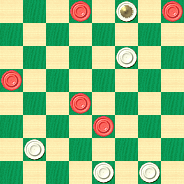The Checker Maven
Jump to navigationX the Unknown

Wouldn't it be nice if, during one of our games, it was our turn to play and suddenly a sign flashed, "Black to Play and Win"? We'd then know to look extra hard for that winning move, and we'd have a good chance of actually finding it.
But real life is not so user-friendly. There are no flashing signs telling us what to do next. If there's a win on the board, we have to both know it's there and find it. Every position is an "X the Unknown" to be solved on our own.
That's why problems with terms like "White to Play, What Result?" are at once frustrating and practical. Frustrating, in that we'd at least like an idea about what we're supposed to do. But practical, in that they mirror the real world of cross-board play, with an unknown result awaiting us at each and every move.
Today's problem is taken from the real world of master play, from a long-ago cross-board game. Can you discern the result and find the right line of play? We're offering you no further information. Here's the position.

WHITE
White to Play, What Result?
W:W32,31,25,11,K3:B23,18,13,4,2.
Can you master the unknown, or will you be X-ed out? When you've worked your way through, though, it's no unknown that clicking on Read More will show you the solution.![]()
Solution
In this situation, White Wins. In the game as actually played between Lieberman and Banks many decades ago, Lieberman didn't know he had a win and played 3-7, leading to a draw after 13-17, etc. But White can instead start with 32-28 and win.
32-28 13-17---A 11-7 2x11 31-26 23x30 3-8 30x21 8x13 and White Wins with the move.
A---13-17 goes down in a flashy manner, but 2-6 is no better, it just loses by a longer route. There are several paths, but this one is instructive. Note how White systematically runs Black out of space and moves: 2-6 3-7 6-9 11-8 4x11 7x16 13-17 25-21 17-22 16-19 23-26 28-24 26-30 19-15 30-26 24-20 26-30 20-16 30-26 16-11 26-23 11-7 23-26 7-2 9-13 2-7 26-23 7-10 23-26 10-14 26-23 21-17 22-26 31x22 18x25 15-18 13x22 18x27 22-26 27-23 26-30 14-17 25-29 17-22 White Wins.
You can email the Webmaster with comments on this article.
